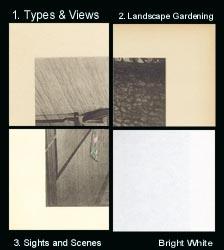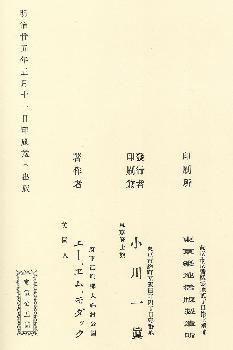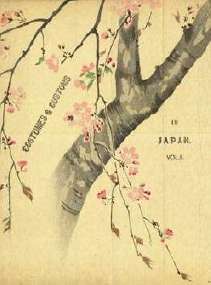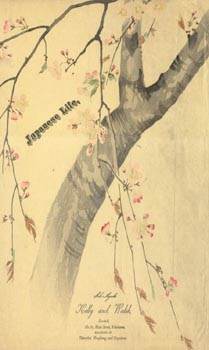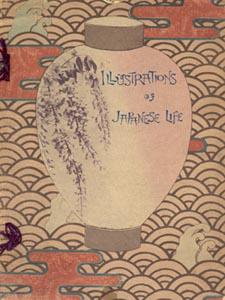|
~~ Book 1895150121 ~~
Views of Tokyo in Collotype
by K. Ogawa

Condition. The book is in Good condition. The binding is solid and all 60 plates are present and free of marking. The covers and ties are soiled and the cover edges have numerous scrapes and small tears. There is a circular handstamp (1 inch diameter) at the upper right on the front cover. There is evidence of erasure of pencil writing in the area of the title on the front cover. At the bottom left of the front cover there is an area (ca 2 mm diameter) where the paper is broken and almost loose. The plate paper is age toned. This is particularly so at the back where some of the upper right corners are darkened. There is moderate foxing scattered throughout the book but it seldom intrudes into the image area.
Ogawa, Kazumasa:
Views of Tokyo in Collotype by K. Ogawa, Photographer, Tokyo, horizontal 8vo (10 1/8 x 6 3/4 in - 25.5 x 17.4 cm), 1895 (Meiji 28), decorated card covers, string ties, 60 black and white collotype plates. The plates are printed on card stock and on only on one side. Each plate is numbered and contains a caption below the collotype image. There is one tissue guard and it is placed before the first plate. The images are in horizontal formate (landscape). A few images are much taller than wide and those are displayed with the bottom of the image at the fore edge of the book.
The covers on this book are unusual in that they are a variant of the covers Ogawa used on his Views and Types series of collotype photo albums/books (see below).
The collotype images vary slightly in size. They generally take up 40-60% of the plate and measure approximately 5 3/4 x 4 1/4 in - 14.5 x 11 cm
The 10th image ("10. The garden in Tokyo of the Chief of the Liu Kiu islands.") is a seldom photographed location. In 1879 The Ryukyu Islands (Liu Kiu islands) were annexed by Japan. The then King (Sho Tai - 1843-1901) was given the Japanese title of Marquis and relocated (essentially exiled) to Tokyo. This appears to be the garden in his residence in exile in Tokyo. This is the only image I have encountered relating to this.
No Title Page.
[Banding seen on the images is caused by scanner and is not on the plate.]
1. Castle grounds, inner moat.
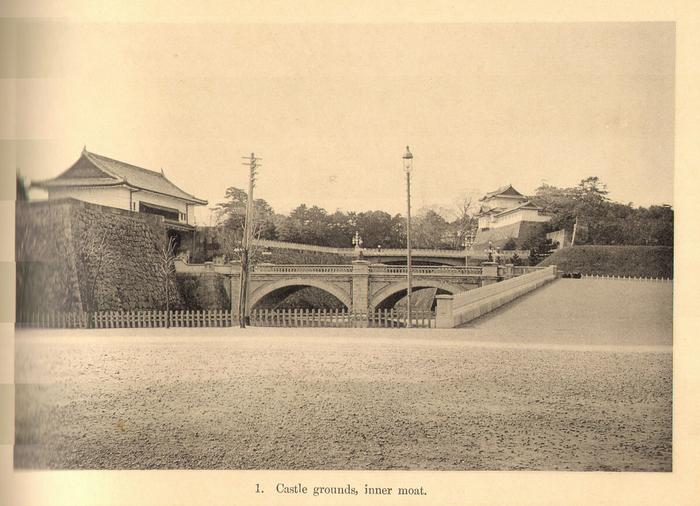
Click on image above for larger picture.
2. Moat(Ojo Uchibori), castle grounds.
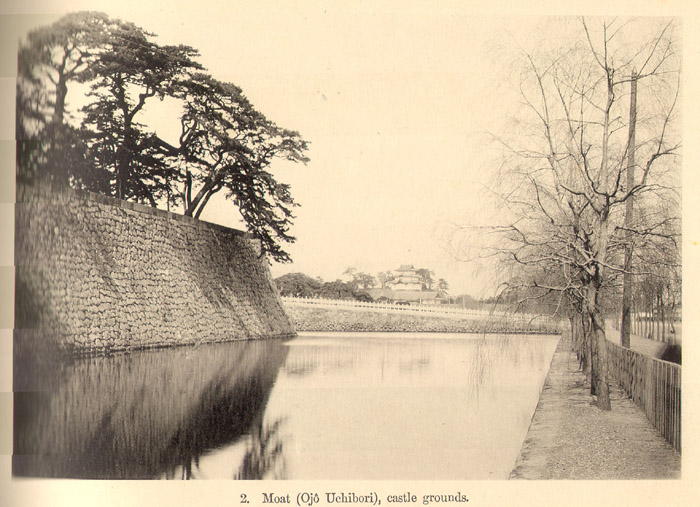 3. View from the Atagoyama hill.
3. View from the Atagoyama hill.
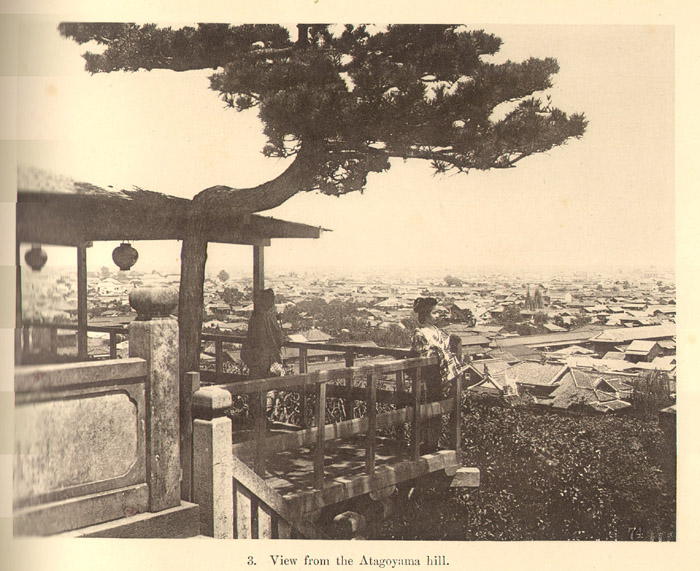 4. Votive stone lanterns at the entrance to temples at Shiba park.
4. Votive stone lanterns at the entrance to temples at Shiba park.
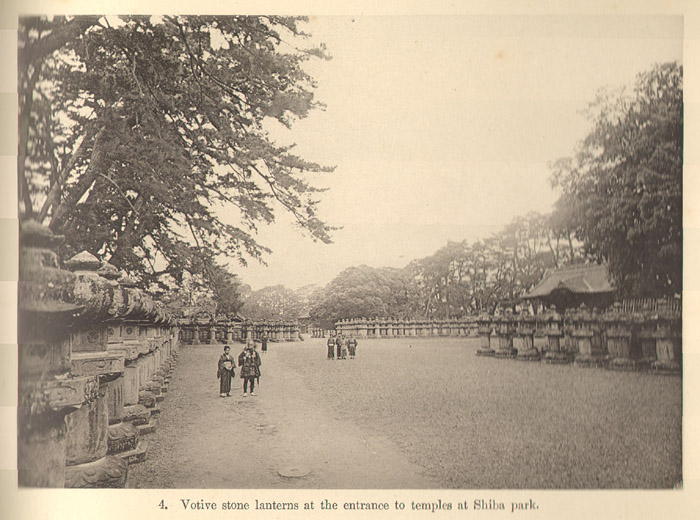 5. Entrance to the Tokugawa Iyenobu shrine, Shiba park.
5. Entrance to the Tokugawa Iyenobu shrine, Shiba park.
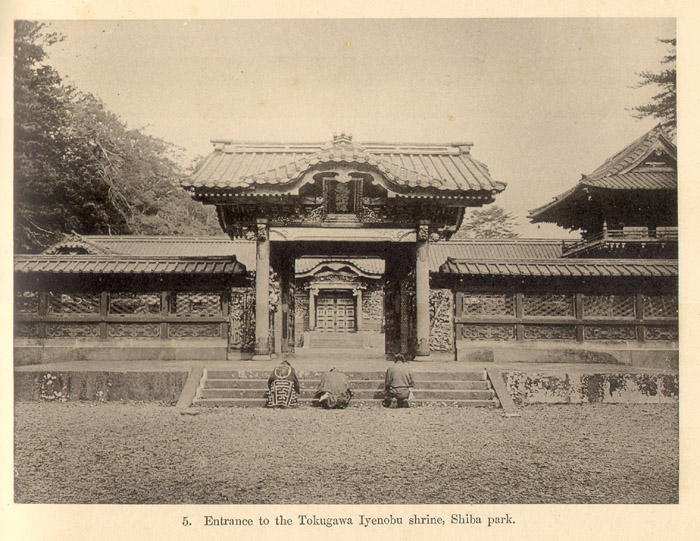 6. Shrine and tomb of the 12th Shogun in Shiba park.
6. Shrine and tomb of the 12th Shogun in Shiba park.
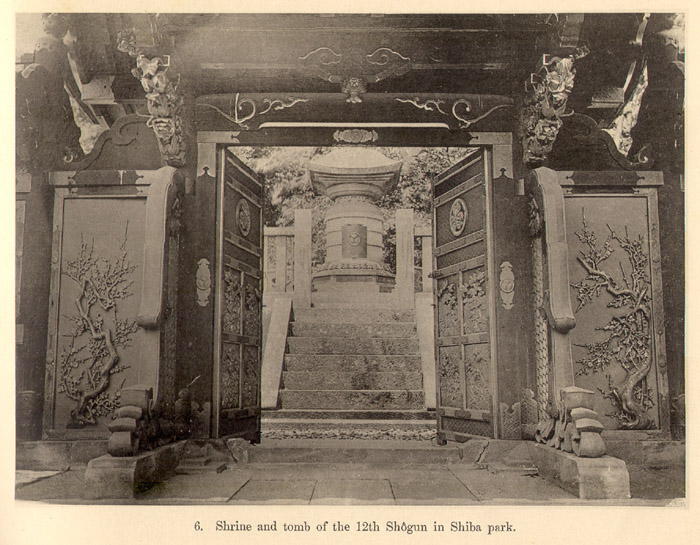 7. Entrance to the Tokugawa Iyetsugu shrine, Shiba park.
7. Entrance to the Tokugawa Iyetsugu shrine, Shiba park.
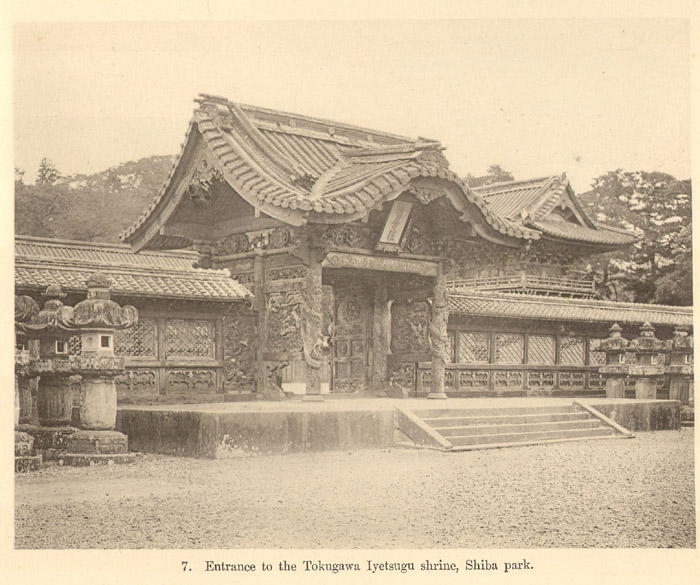 8. Tomb of Iyeshige (14th Shogun) Shiba park.
8. Tomb of Iyeshige (14th Shogun) Shiba park.
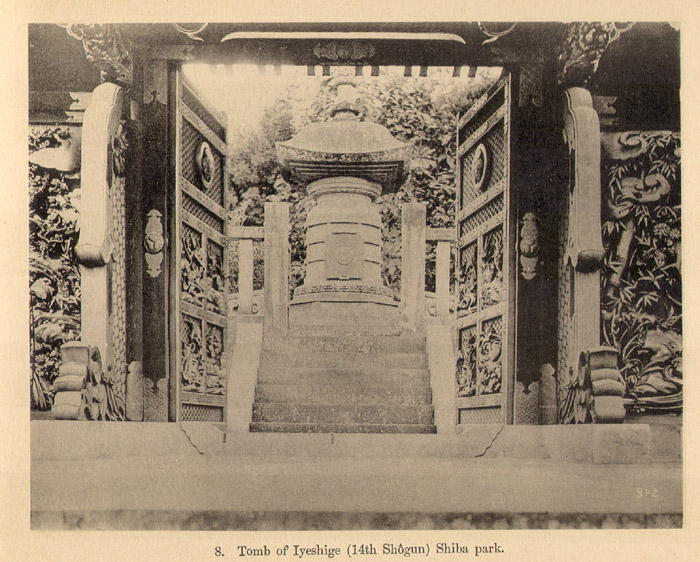 9. Entrance to the Rokumeikwan (building for official receptions and the Tokyo Club.
9. Entrance to the Rokumeikwan (building for official receptions and the Tokyo Club.
 10. The garden in Tokyo of the Chief of the Liu Kiu islands.
10. The garden in Tokyo of the Chief of the Liu Kiu islands.
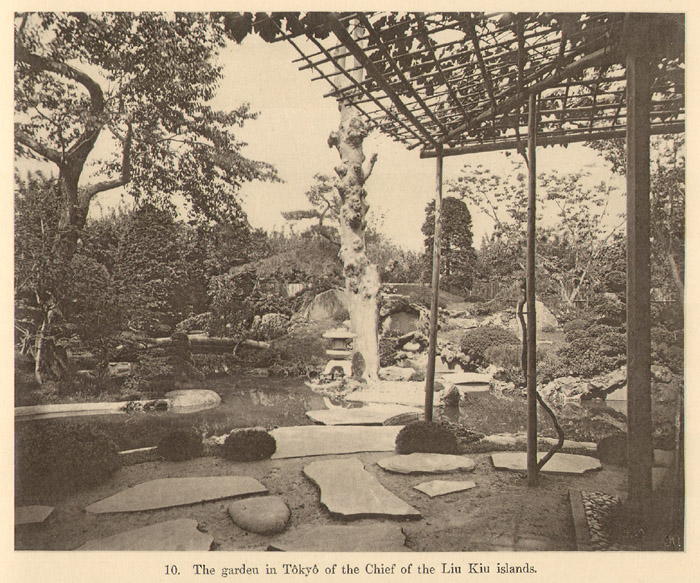
Click on image above for larger picture.
11. Entrance to a nobleman's residence; ancient style.
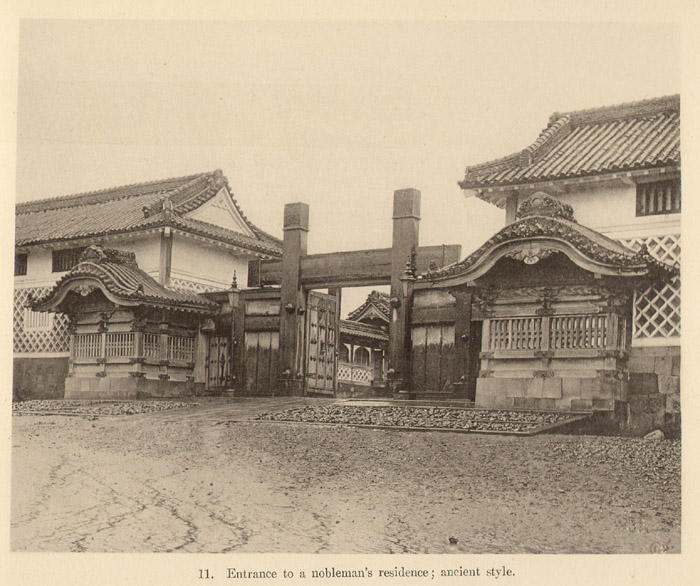 12. Imperial Hotel.
12. Imperial Hotel.
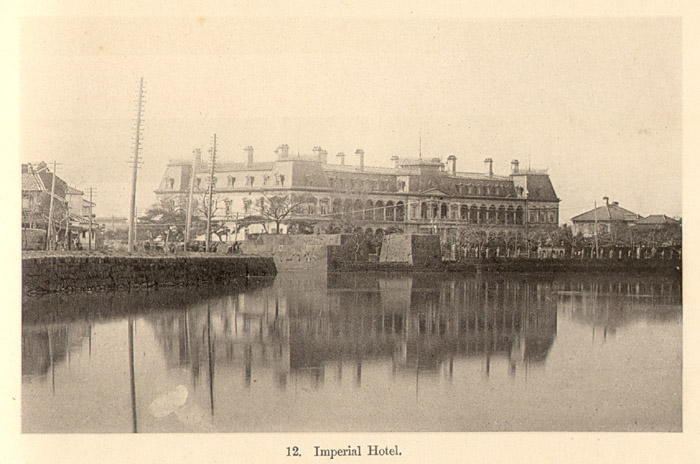 13. Scene in the garden at Mitoyashiki.
13. Scene in the garden at Mitoyashiki.
 14. Entrance to an Imperial building formerly a Diamiyo's palace and now
used by the Army Department.
14. Entrance to an Imperial building formerly a Diamiyo's palace and now
used by the Army Department.
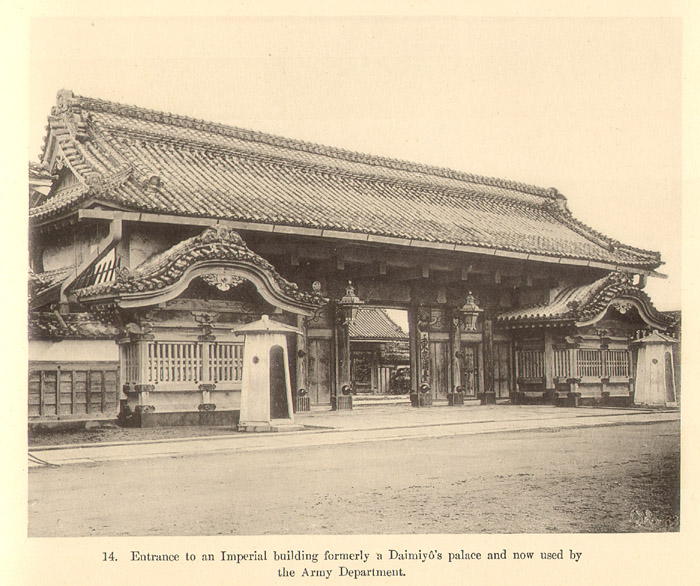 15. View of Army Bureau from the Sakurada moat
15. View of Army Bureau from the Sakurada moat
 16. Front view of Shinto shrine in commemoration of soldiers killed in war,
Top of Kudan Hill.
16. Front view of Shinto shrine in commemoration of soldiers killed in war,
Top of Kudan Hill.
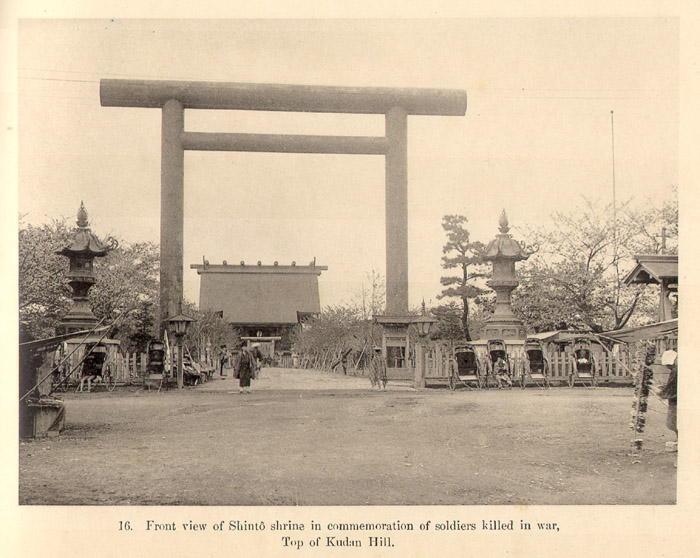 17. View of castle from near Kojimahchi.
17. View of castle from near Kojimahchi.
 18. The temporary Houses of Parliament.
18. The temporary Houses of Parliament.
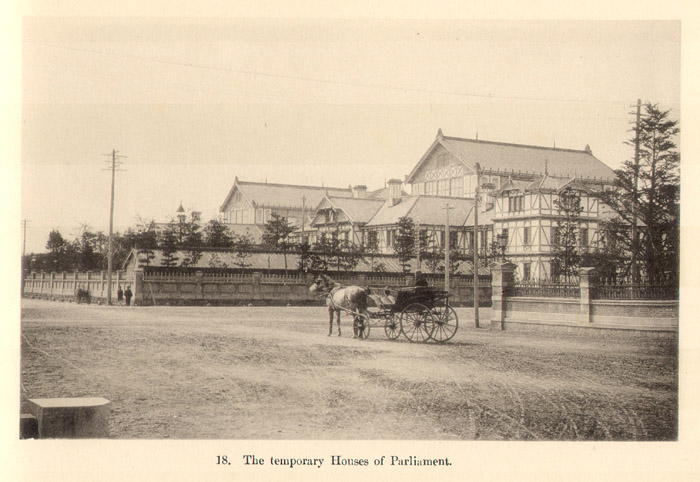 19. Interior, House of Peers.
19. Interior, House of Peers.
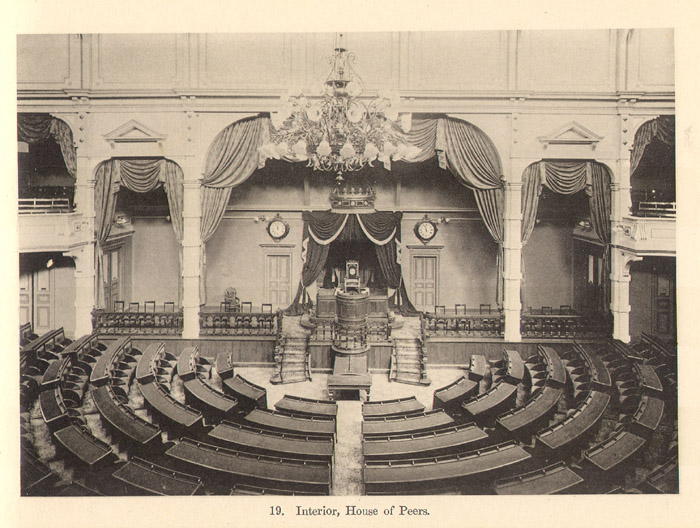 20. Interior, House of Commons.
20. Interior, House of Commons.
 21. The Ginza Street viewed from Shimbashi.
21. The Ginza Street viewed from Shimbashi.
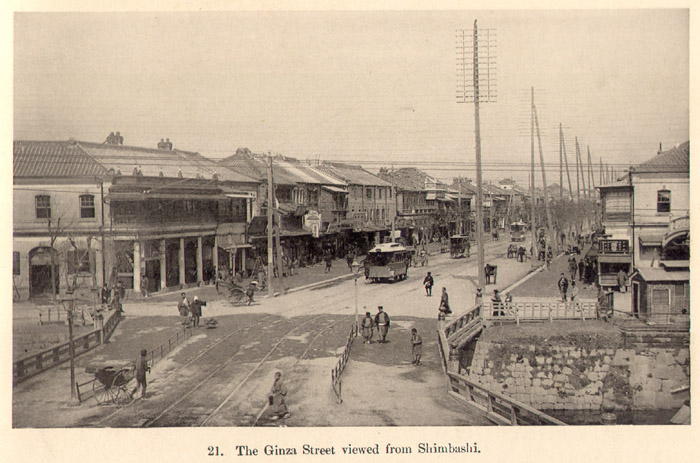 22. Front of Shintomiza theatre.
22. Front of Shintomiza theatre.
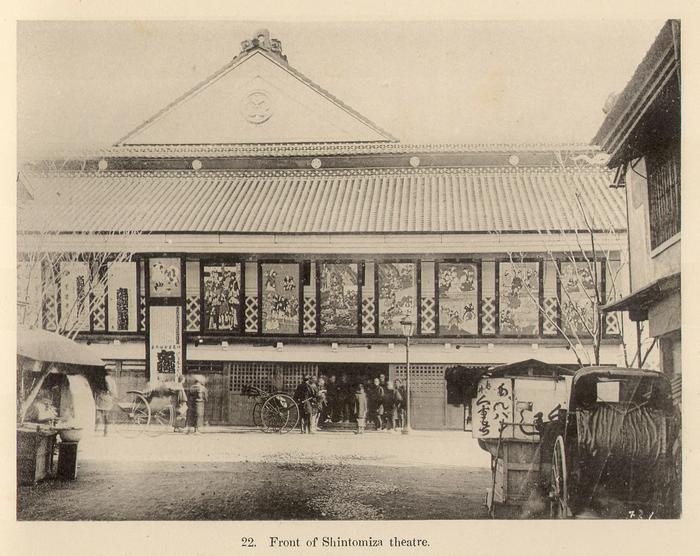 23. Geisha (dancing-girls) houses, near Ginza.
23. Geisha (dancing-girls) houses, near Ginza.
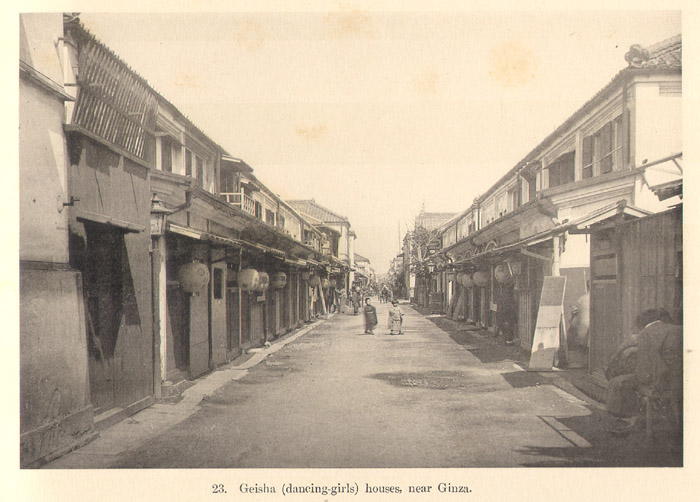 24. Junks off the bund Tsukiji.
24. Junks off the bund Tsukiji.
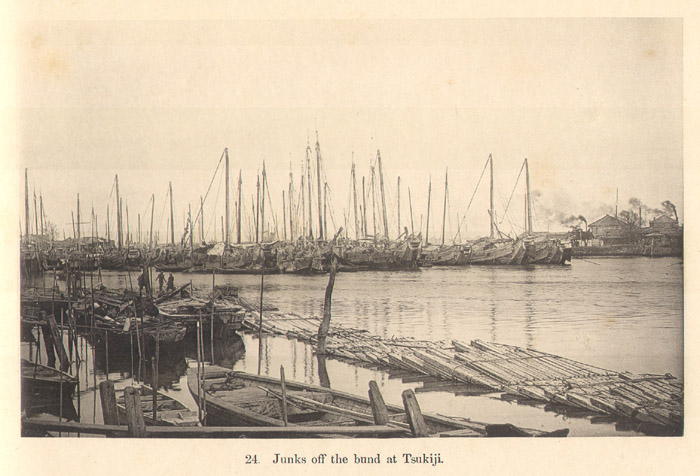 25. The Hotel Metropole.
25. The Hotel Metropole.
 26. Japanese Junk, taken at the mouth
of the Sumida river.
26. Japanese Junk, taken at the mouth
of the Sumida river.
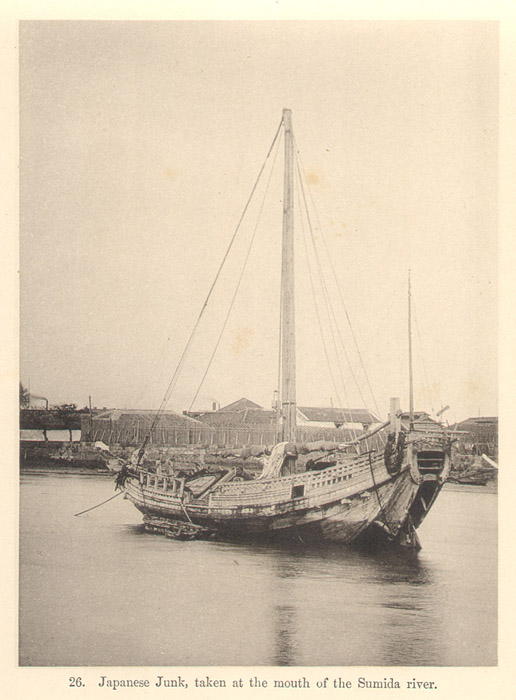
Click on image above for larger picture.
27. Fishing off Susaki, Fukagawa.
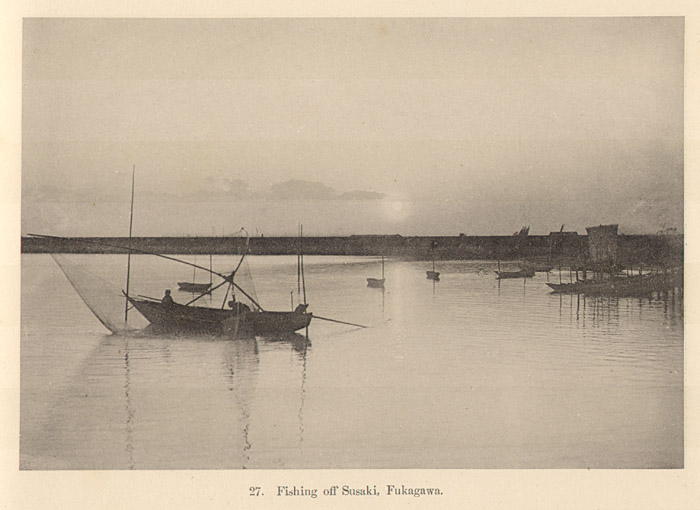 28. Wrestlers at Riogoku.
28. Wrestlers at Riogoku.
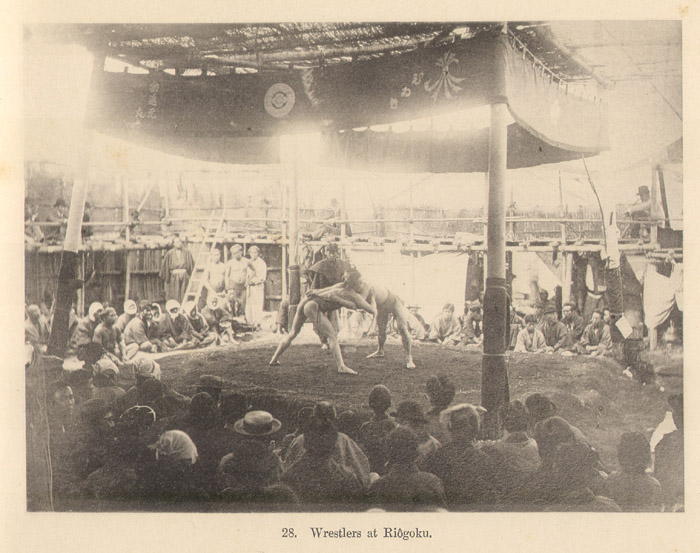 29. Warehouse and cargo boats, view from Aramebashi (bridge).
29. Warehouse and cargo boats, view from Aramebashi (bridge).
 30. Maqin road in the Uweno Park.
30. Maqin road in the Uweno Park.
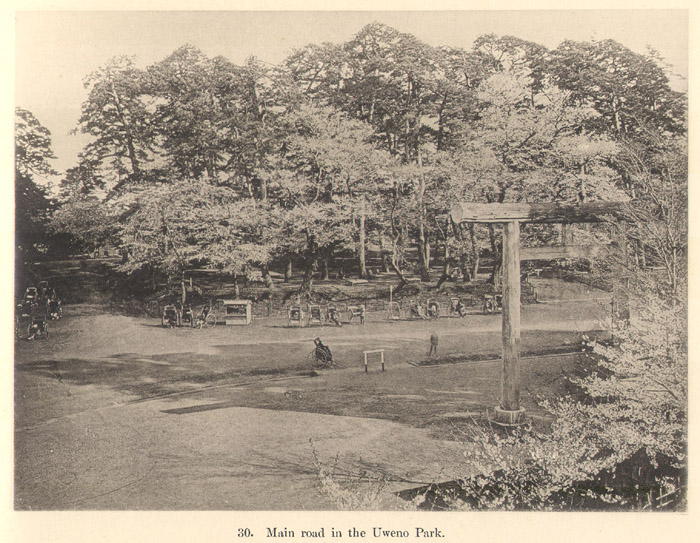 31. Road at Uweno park leading to Iyemitsu shrine.
31. Road at Uweno park leading to Iyemitsu shrine.
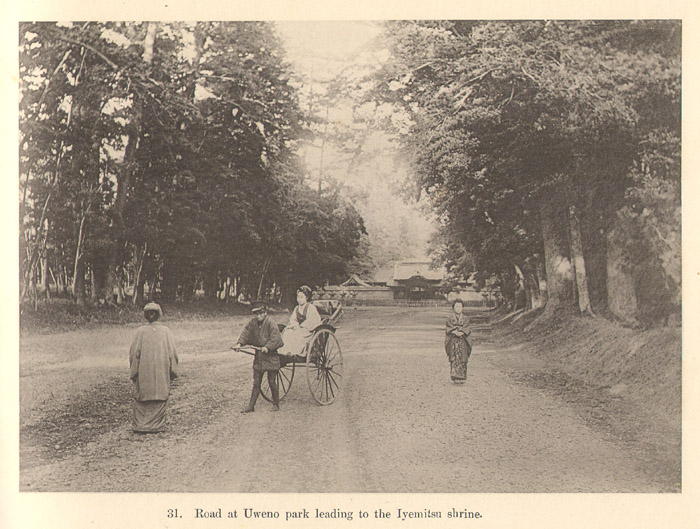 32. Refreshment booths during the cherry blossom
season at Uweno park.
32. Refreshment booths during the cherry blossom
season at Uweno park.
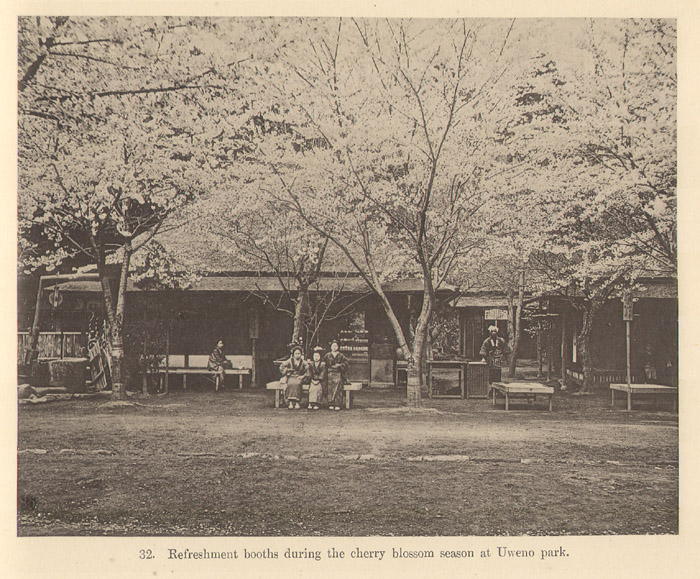 33. Votive stone saterns in front of the Shogun's
(Iyeyasu) temple Uweno.
33. Votive stone saterns in front of the Shogun's
(Iyeyasu) temple Uweno.
 34. View from the hill in Uweno park.
34. View from the hill in Uweno park.
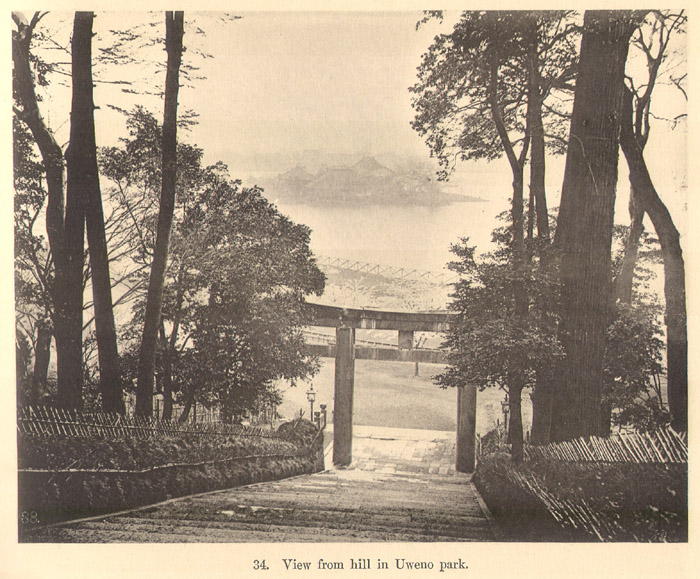 35. Front of Asakusa Temple.
35. Front of Asakusa Temple.
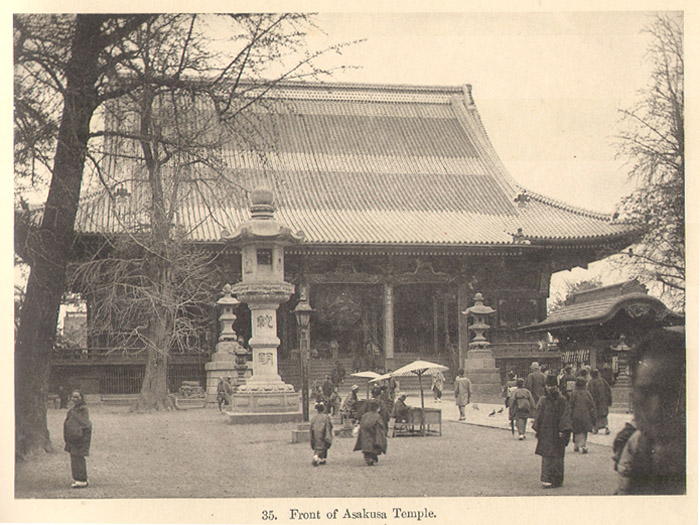 36. Interior of Asakusa temple.
36. Interior of Asakusa temple.
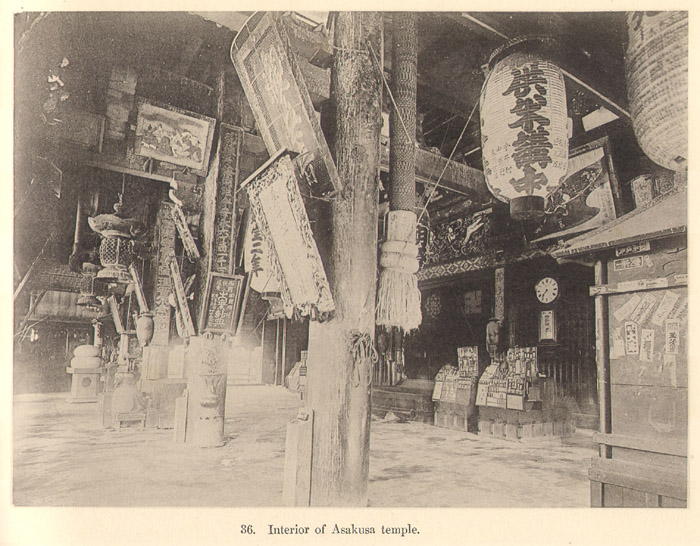 37. Shows at Asakusa temple grounds.
37. Shows at Asakusa temple grounds.
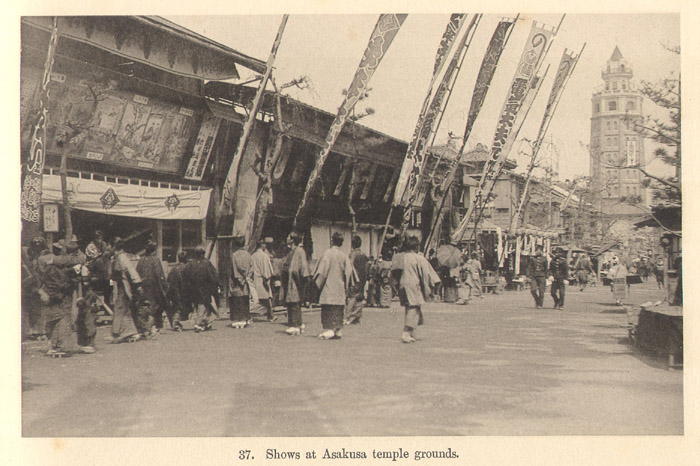 38. Pagoda, Asakusa Temple.
38. Pagoda, Asakusa Temple.
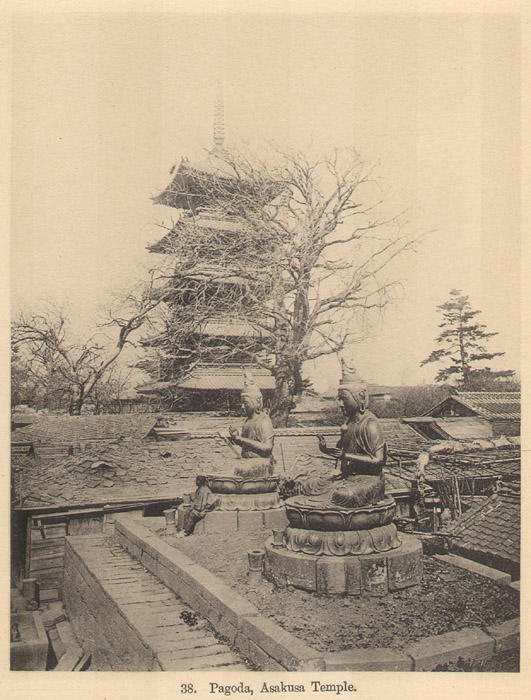 39. Twelve storied tower in the temple
grounds at Asakusa.
39. Twelve storied tower in the temple
grounds at Asakusa.
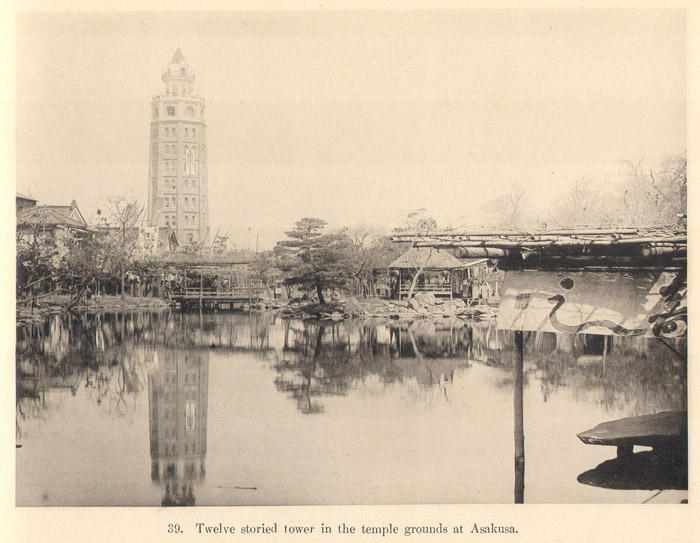
Click on image above for larger picture.
40. Entrance to the Yoshiwara grounds.
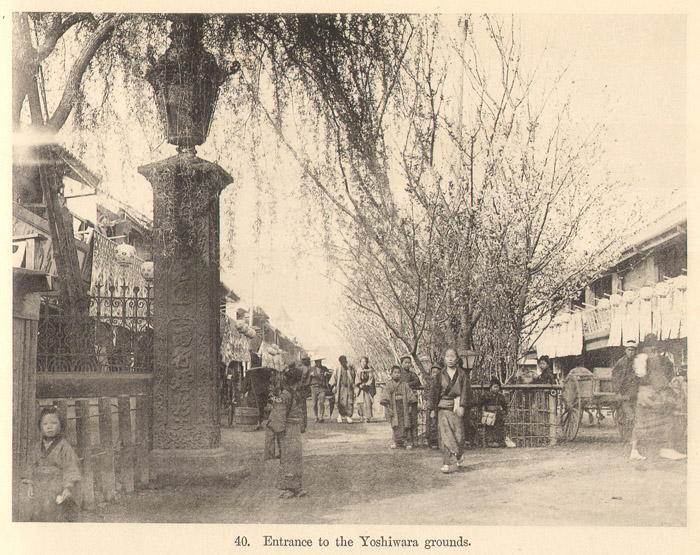 41. Snow scene with pleasure boats on river at Sanyabori.
41. Snow scene with pleasure boats on river at Sanyabori.
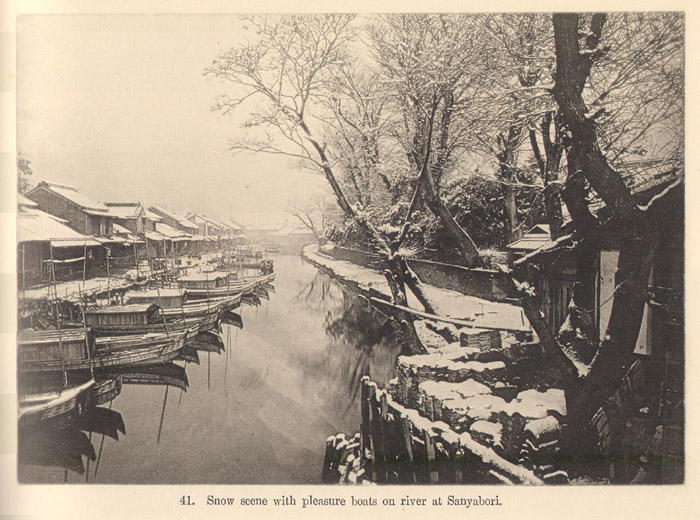 42. Cherry trees in blossom on the banks of the Sumida river.
42. Cherry trees in blossom on the banks of the Sumida river.
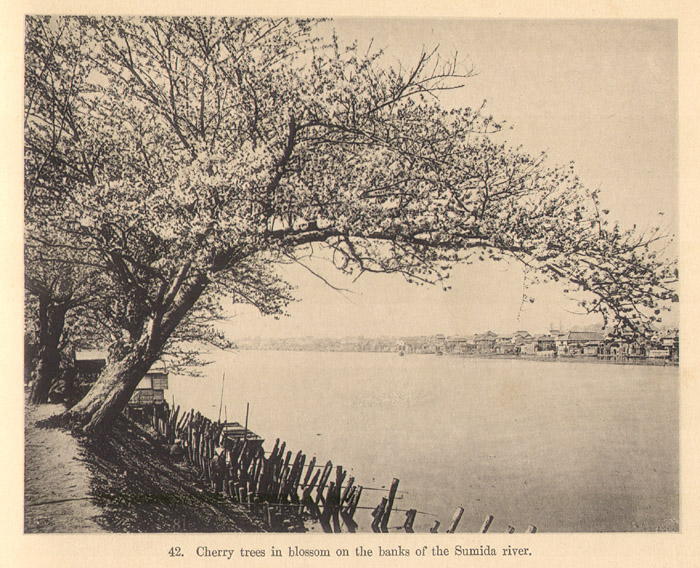 43. Scene on the Sumida river.
43. Scene on the Sumida river.
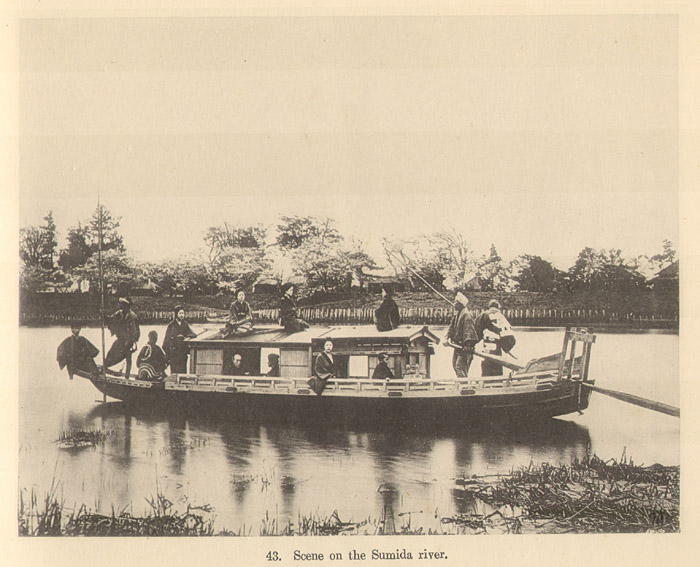 44. Fishing on the Sumida river.
44. Fishing on the Sumida river.
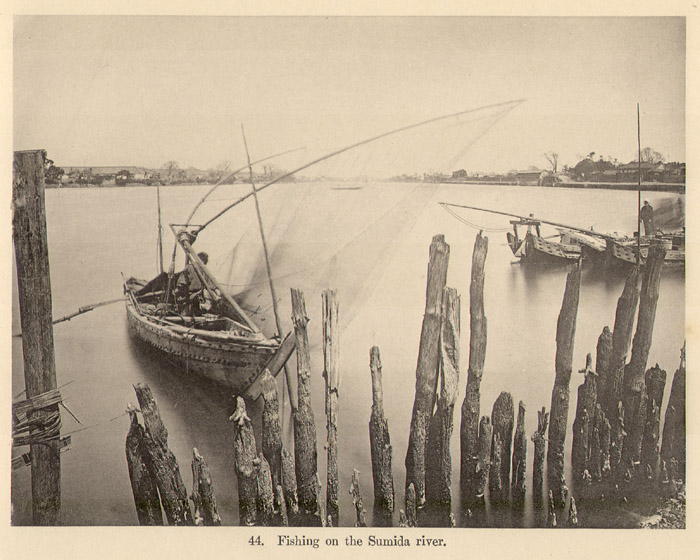 45. Cherry trees on the banks of the Sumida river.
45. Cherry trees on the banks of the Sumida river.
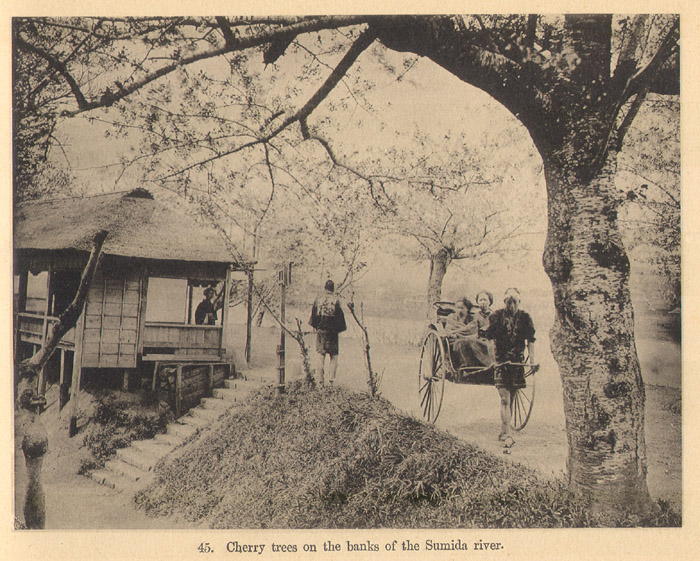 46. Work in the paddy fields at Oji.
46. Work in the paddy fields at Oji.
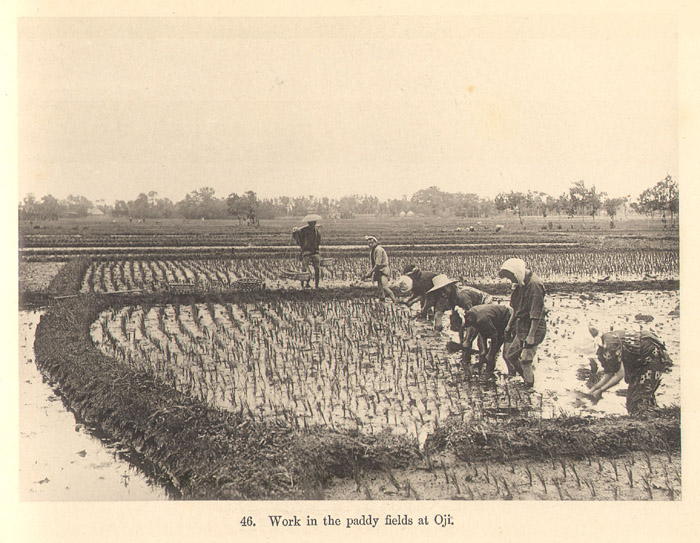 47. Wisteria in flower at Kameido Temple grounds, Honjo.
47. Wisteria in flower at Kameido Temple grounds, Honjo.
 48. Bamboo grove at Meguro
48. Bamboo grove at Meguro
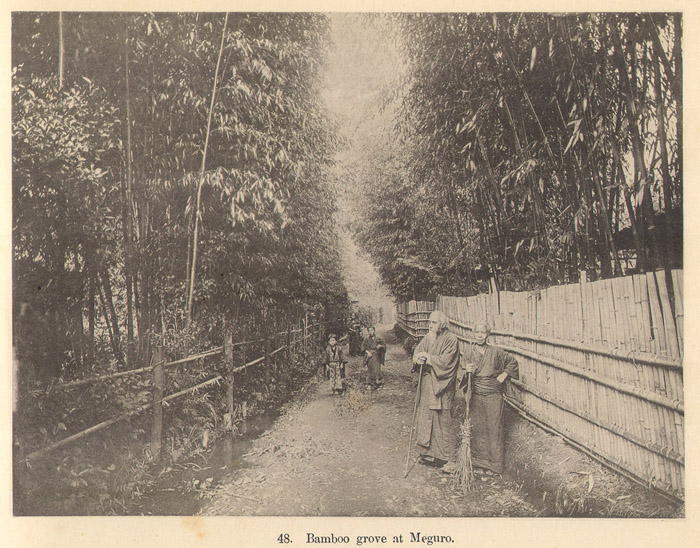
Click on image above for larger picture.
49. Display of Peony flowers.
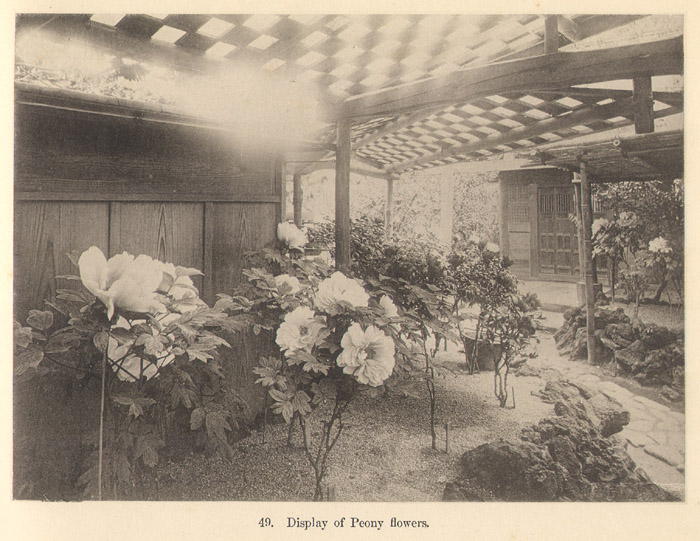 50. Iris in flower at Horikiri.
50. Iris in flower at Horikiri.
 51. Display of Chrysanthemum flowers at Dangozaka.
51. Display of Chrysanthemum flowers at Dangozaka.
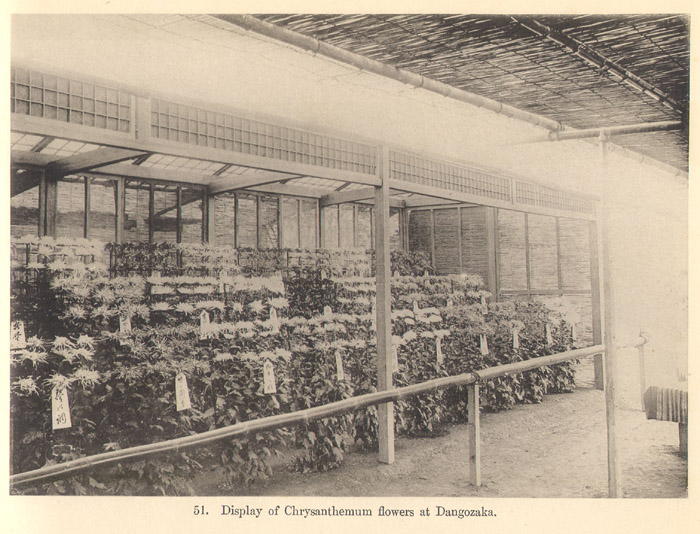 52. Private garden, Oji.
52. Private garden, Oji.
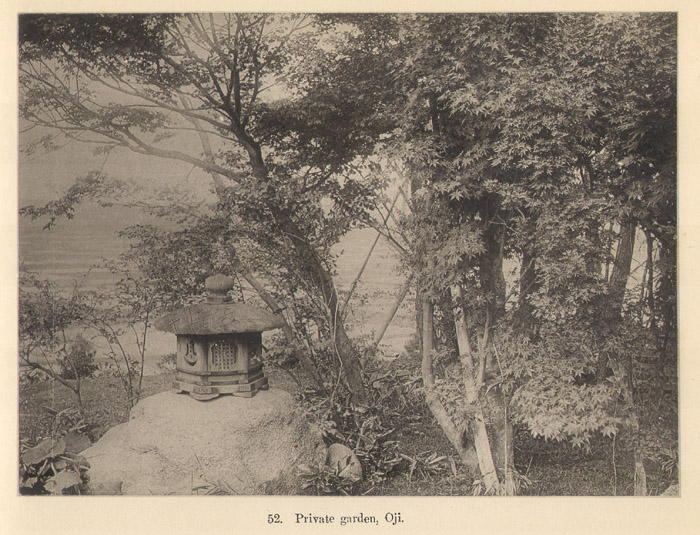 53. Tea houses at Oji.
53. Tea houses at Oji.
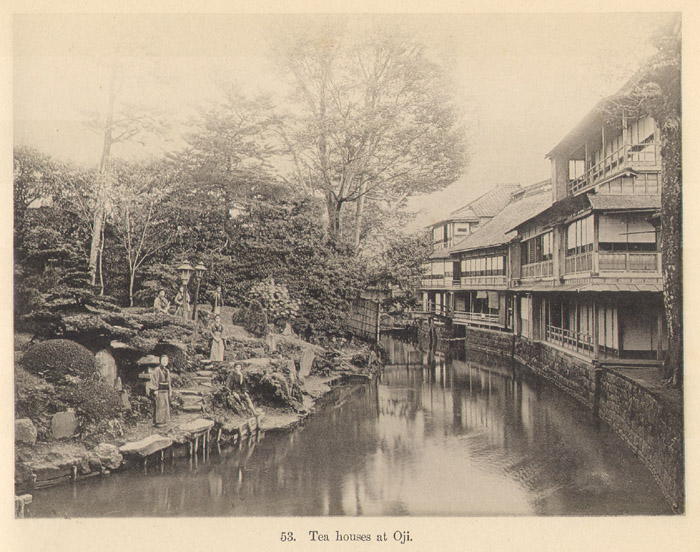 54. View of Maple trees at Takinogawa, Oji.
54. View of Maple trees at Takinogawa, Oji.
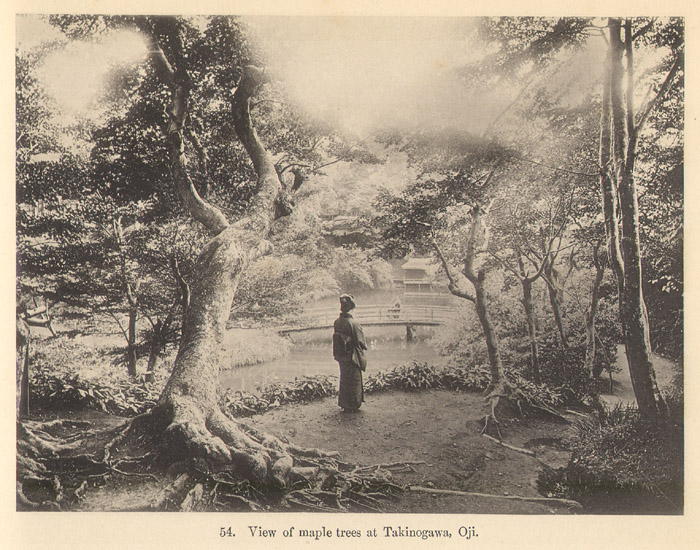 55. Scene at the sea-side of Omori, (collecting sea-weed).
55. Scene at the sea-side of Omori, (collecting sea-weed).
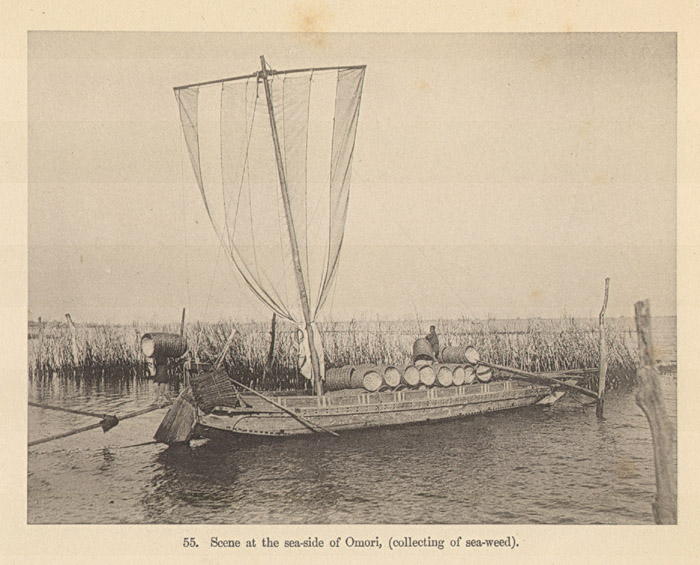 56. Tombs of the 47 Ronin (loyal retainers) at Takanawa.
56. Tombs of the 47 Ronin (loyal retainers) at Takanawa.
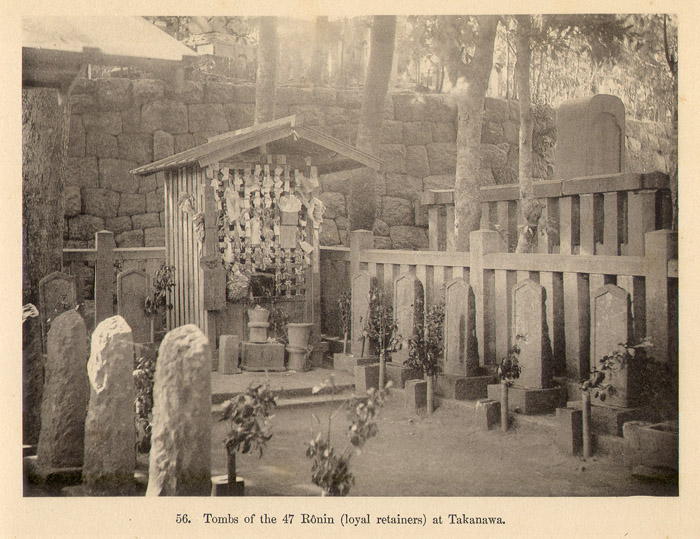
Click on image above for larger picture.
57. Effigies of the 47 Ronin or loyal retainers in Sengakuji temple Takanawa.
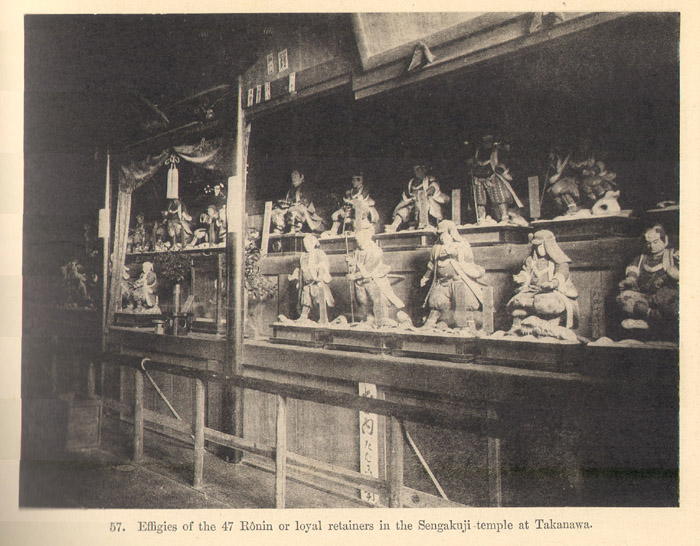 58. Castle moat during lotus season.
58. Castle moat during lotus season.
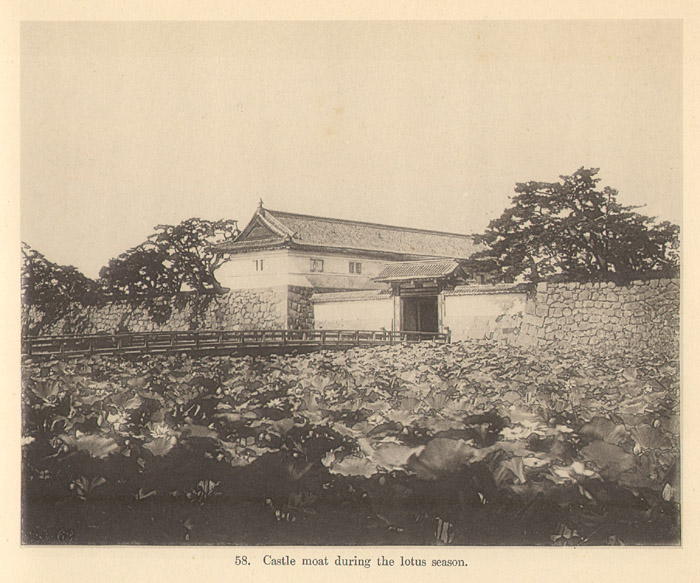 59. Gate and moat, castle grounds.
59. Gate and moat, castle grounds.
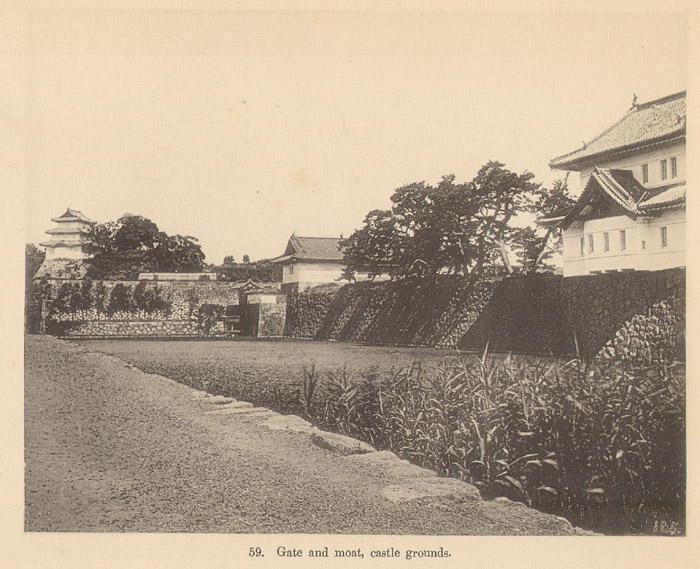 60. The inner moat round the castle.
60. The inner moat round the castle.
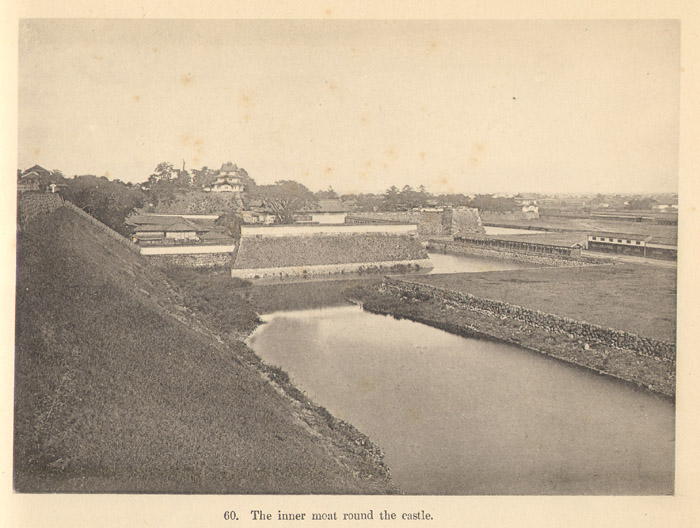
Close up of Collotpye Printing
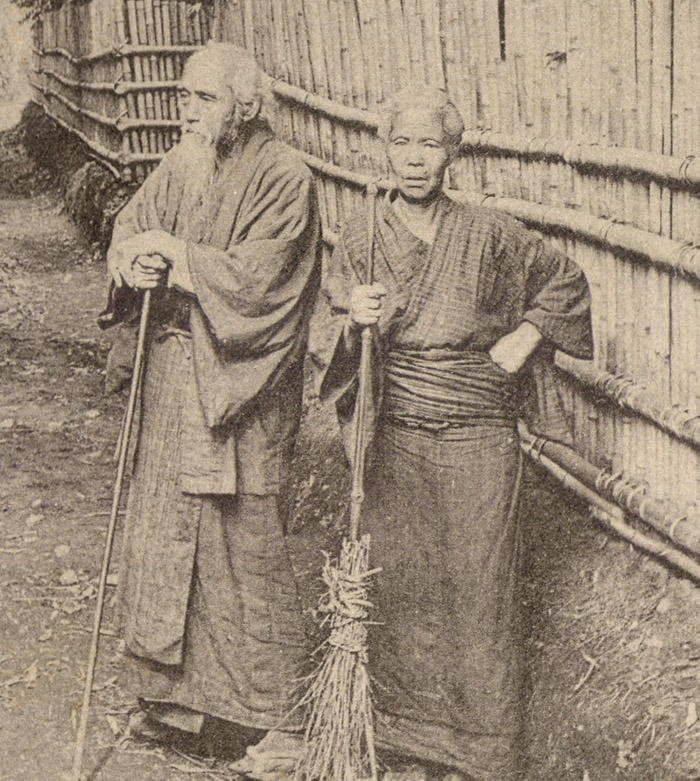
Click on image above for larger picture.
Colophon (inside back cover):
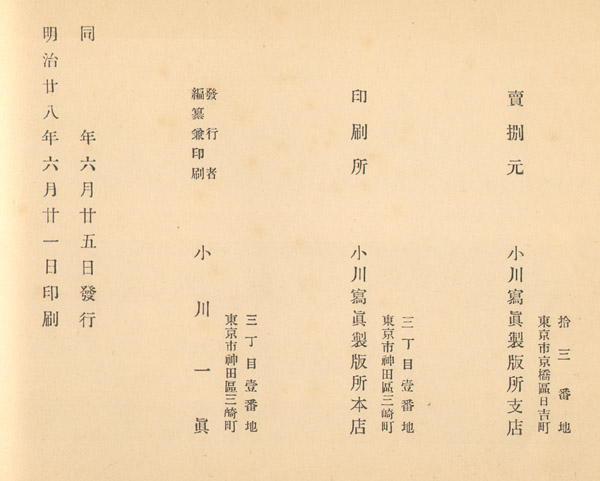
Click on image above for larger picture.
Printed: Meiji 28 (1895).6.21
Published: Meiji 28 (1895).6.25
Address on Far Left in Colophon:
Ogawa Shashin Seihanjo (Seihan Sho)
60 Platea - Captions Only
1. Castle grounds, inner moat.
2. Moat(Ojo Uchibori), castle grounds.
3. View from the Atagoyama hill.
4. Votive stone lanterns at the entrance to temples at Shiba park.
5. Entrance to the Tokugawa Iyenobu shrine, Shiba park.
6. Shrine and tomb of the 12th Shogun in Shiba park.
7. Entrance to the Tokugawa Iyetsugu shrine, Shiba park.
8. Tomb of Iyeshige (14th Shogun) Shiba park.
9. Entrance to the Rokumeikwan (building for official receptions and the Tokyo Club.
10. The garden in Tokyo of the Chief of the Liu Kiu islands.
11. Entrance to a nobleman's residence; ancient style.
12. Imperial Hotel.
13. Scene in the garden at Mitoyashiki.
14. Entrance to an Imperial building formerly a Diamiyo's palace and now used by the Army Department.
15. View of Army Bureau from the Sakurada moat.
16. Front view of Shinto shrine in commemoration of soldiers killed in war, Top of Kudan Hill.
17. View of castle from near Kojimahchi.
18. The temporary Houses of Parliament.
19. Interior, House of Peers.
20. Interior, House of Commons.
21. The Ginza Street viewed from Shimbashi.
22. Front of Shintomiza theatre.
23. Geisha (dancing-girls) houses, near Ginza.
24. Junks off the bund Tsukiji.
25. The Hotel Metropole.
26. Japanese Junk, taken at the mouth of the Sumida river.
27. Fishing off Susaki, Fukagawa.
28. Wrestlers at Riogoku.
29. Warehouse and cargo boats, view from Aramebashi (bridge).
30. Maqin road in the Uweno Park.
31. Road at Uweno park leading to Iyemitsu shrine.
32. Refreshment booths during the cherry blossom season at Uweno park.
33. Votive stone saterns in front of the Shogun's (Iyeyasu) temple Uweno.
34. View from the hill in Uweno park.
35. Front of Asakusa Temple.
36. Interior of Asakusa temple.
37. Shows at Asakusa temple grounds.
38. Pagoda, Asakusa Temple.
39. Twelve storied tower in the temple grounds at Asakusa.
40. Entrance to the Yoshiwara grounds.
41. Snow scene with pleasure boats on river at Sanyabori.
42. Cherry trees in blossom on the banks of the Sumida river.
43. Scene on the Sumida river.
44. Fishing on the Sumida river.
45. Cherry trees on the banks of the Sumida river.
46. Work in the paddy fields at Oji.
47. Wisteria in flower at Kameido Temple grounds, Honjo.
48. Bamboo grove at Meguro
49. Display of Peony flowers.
50. Iris in flower at Horikiri.
51. Display of Chrysanthemum flowers at Dangozaka.
52. Private garden, Oji.
53. Tea houses at Oji.
54. View of Maple trees at Takinogawa, Oji.
55. Scene at the sea-side of Omori, (collecting sea-weed).
56. Tombs of the 47 Ronin (loyal retainers) at Takanawa.
57. Effigies of the 47 Ronin or loyal retainers in Sengakuji temple Takanawa.
58. Castle moat during lotus season.
59. Gate and moat, castle grounds.
60. The inner moat round the castle.
|


 3. View from the Atagoyama hill.
3. View from the Atagoyama hill.
 4. Votive stone lanterns at the entrance to temples at Shiba park.
4. Votive stone lanterns at the entrance to temples at Shiba park.
 5. Entrance to the Tokugawa Iyenobu shrine, Shiba park.
5. Entrance to the Tokugawa Iyenobu shrine, Shiba park.
 6. Shrine and tomb of the 12th Shogun in Shiba park.
6. Shrine and tomb of the 12th Shogun in Shiba park.
 7. Entrance to the Tokugawa Iyetsugu shrine, Shiba park.
7. Entrance to the Tokugawa Iyetsugu shrine, Shiba park.
 8. Tomb of Iyeshige (14th Shogun) Shiba park.
8. Tomb of Iyeshige (14th Shogun) Shiba park.
 9. Entrance to the Rokumeikwan (building for official receptions and the Tokyo Club.
9. Entrance to the Rokumeikwan (building for official receptions and the Tokyo Club.
 10. The garden in Tokyo of the Chief of the Liu Kiu islands.
10. The garden in Tokyo of the Chief of the Liu Kiu islands.

 12. Imperial Hotel.
12. Imperial Hotel.
 13. Scene in the garden at Mitoyashiki.
13. Scene in the garden at Mitoyashiki.
 14. Entrance to an Imperial building formerly a Diamiyo's palace and now
used by the Army Department.
14. Entrance to an Imperial building formerly a Diamiyo's palace and now
used by the Army Department.
 15. View of Army Bureau from the Sakurada moat
15. View of Army Bureau from the Sakurada moat
 16. Front view of Shinto shrine in commemoration of soldiers killed in war,
Top of Kudan Hill.
16. Front view of Shinto shrine in commemoration of soldiers killed in war,
Top of Kudan Hill.
 17. View of castle from near Kojimahchi.
17. View of castle from near Kojimahchi.
 18. The temporary Houses of Parliament.
18. The temporary Houses of Parliament.
 19. Interior, House of Peers.
19. Interior, House of Peers.
 20. Interior, House of Commons.
20. Interior, House of Commons.
 21. The Ginza Street viewed from Shimbashi.
21. The Ginza Street viewed from Shimbashi.
 22. Front of Shintomiza theatre.
22. Front of Shintomiza theatre.
 23. Geisha (dancing-girls) houses, near Ginza.
23. Geisha (dancing-girls) houses, near Ginza.
 24. Junks off the bund Tsukiji.
24. Junks off the bund Tsukiji.
 25. The Hotel Metropole.
25. The Hotel Metropole.


 28. Wrestlers at Riogoku.
28. Wrestlers at Riogoku.
 29. Warehouse and cargo boats, view from Aramebashi (bridge).
29. Warehouse and cargo boats, view from Aramebashi (bridge).
 30. Maqin road in the Uweno Park.
30. Maqin road in the Uweno Park.
 31. Road at Uweno park leading to Iyemitsu shrine.
31. Road at Uweno park leading to Iyemitsu shrine.
 32. Refreshment booths during the cherry blossom
season at Uweno park.
32. Refreshment booths during the cherry blossom
season at Uweno park.
 33. Votive stone saterns in front of the Shogun's
(Iyeyasu) temple Uweno.
33. Votive stone saterns in front of the Shogun's
(Iyeyasu) temple Uweno.
 34. View from the hill in Uweno park.
34. View from the hill in Uweno park.
 35. Front of Asakusa Temple.
35. Front of Asakusa Temple.
 36. Interior of Asakusa temple.
36. Interior of Asakusa temple.
 37. Shows at Asakusa temple grounds.
37. Shows at Asakusa temple grounds.
 38. Pagoda, Asakusa Temple.
38. Pagoda, Asakusa Temple.
 39. Twelve storied tower in the temple
grounds at Asakusa.
39. Twelve storied tower in the temple
grounds at Asakusa.


 42. Cherry trees in blossom on the banks of the Sumida river.
42. Cherry trees in blossom on the banks of the Sumida river.
 43. Scene on the Sumida river.
43. Scene on the Sumida river.
 44. Fishing on the Sumida river.
44. Fishing on the Sumida river.
 45. Cherry trees on the banks of the Sumida river.
45. Cherry trees on the banks of the Sumida river.
 46. Work in the paddy fields at Oji.
46. Work in the paddy fields at Oji.
 47. Wisteria in flower at Kameido Temple grounds, Honjo.
47. Wisteria in flower at Kameido Temple grounds, Honjo.
 48. Bamboo grove at Meguro
48. Bamboo grove at Meguro

 50. Iris in flower at Horikiri.
50. Iris in flower at Horikiri.
 51. Display of Chrysanthemum flowers at Dangozaka.
51. Display of Chrysanthemum flowers at Dangozaka.
 52. Private garden, Oji.
52. Private garden, Oji.
 53. Tea houses at Oji.
53. Tea houses at Oji.
 54. View of Maple trees at Takinogawa, Oji.
54. View of Maple trees at Takinogawa, Oji.
 55. Scene at the sea-side of Omori, (collecting sea-weed).
55. Scene at the sea-side of Omori, (collecting sea-weed).
 56. Tombs of the 47 Ronin (loyal retainers) at Takanawa.
56. Tombs of the 47 Ronin (loyal retainers) at Takanawa.

 58. Castle moat during lotus season.
58. Castle moat during lotus season.
 59. Gate and moat, castle grounds.
59. Gate and moat, castle grounds.
 60. The inner moat round the castle.
60. The inner moat round the castle.



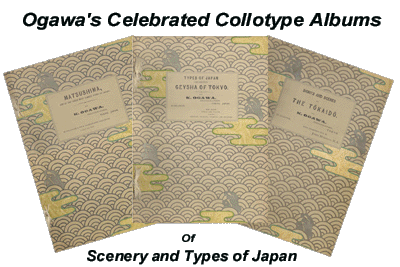
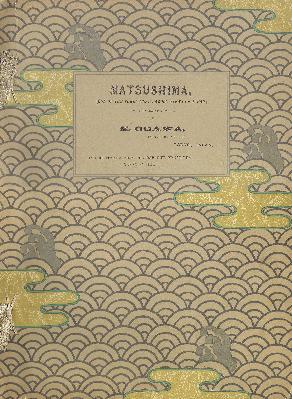
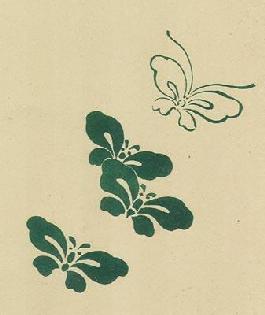

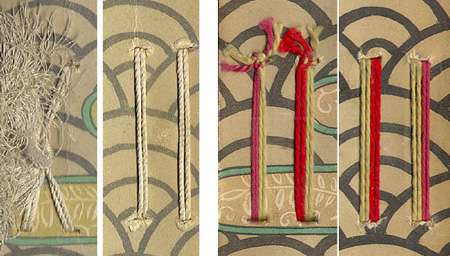

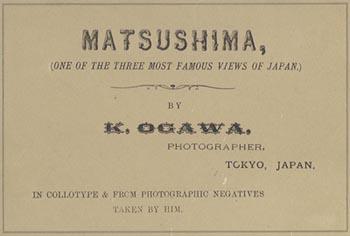
 Types and View books
Types and View books Landscape Gardening Supplement (1893)
Landscape Gardening Supplement (1893)
 Sights and Scenes in Fair Japan (1910)
Sights and Scenes in Fair Japan (1910)
 Bright white paper for comparison
Bright white paper for comparison
